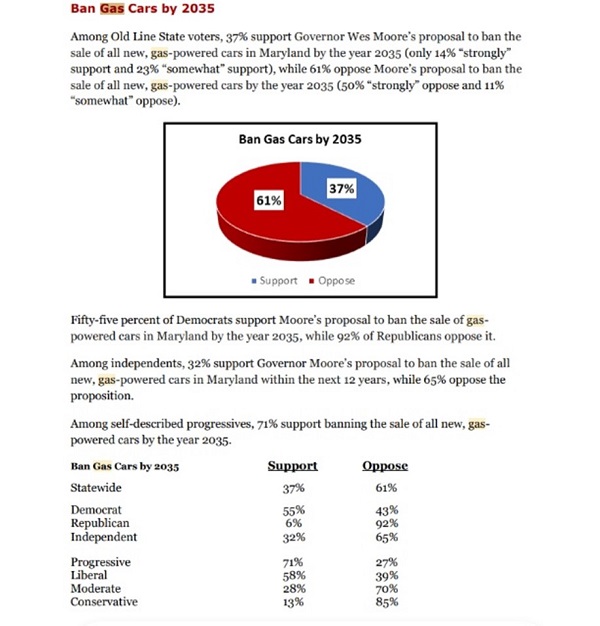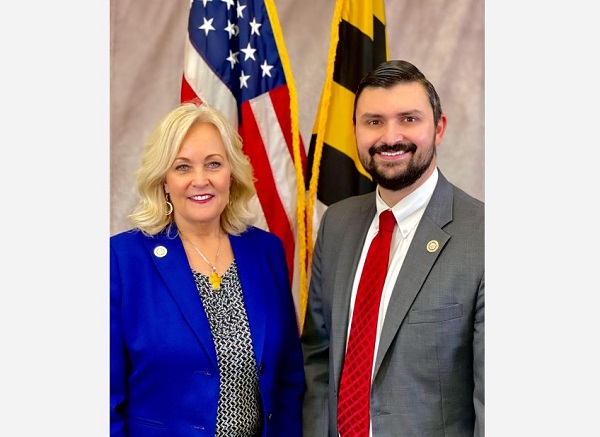The following is an op-ed piece from Delegates Kathy Szeliga and Ryan Nawrocki.
Mark Twain wisely said, “No man’s life, liberty, or property are safe while the legislature is in session.” This rang true in 2023 when Governor Moore and radical liberals in Annapolis announced that Maryland would follow California with rules to phase out the sale of new, gasoline or diesel-powered cars or trucks. Maryland will require 50% of the vehicles sold in the state to be electric within the next four years and will have a total ban on the sale of gas or diesel-powered cars by 2035. The Governor is calling for a major shift in the state’s vehicle market. What does that mean for you? It means that the next time you need to buy a car, the cost is going up! In fact, you may have to buy a $60,000+ electric car that has inadequate charging facilities around the state!
Now months after session has ended, a newly released poll looks at how Marylanders feel about topics ranging from stricter gun laws to a ban on gas-powered vehicles. The results of the poll taken by 840 Marylanders were not that surprising but may shock the liberals in Annapolis. A majority of Marylanders say they oppose banning the sale of gas-powered vehicles, no matter their political party affiliation. The poll was released last week by Annapolis-based Gonzales Research & Media Service and showed that statewide, 37% support a ban on the sale of all new, gas-powered cars in the state by 2035 (a trifle 14% “strongly” favor), while 61% oppose banning the sale of all new, gas-powered cars in Maryland by the year 2035 (50% “strongly” oppose). Support bumps up to 44% when voters are informed that it might mean a significant reduction in carbon dioxide emissions being released in the state, and drops down to 29% when informed that it might mean a significant increase in the average cost of a car. While the public is conflicted over this issue, the groundwork for it has been laid for years here in Maryland.
Back in 2007, the Maryland Clean Cars Act required the Department of the Environment to adopt regulations implementing the California Clean Car Program. In August of 2022, California adopted new regulations that would ultimately ban the state’s sale of gas or diesel cars or trucks. California’s regulation accelerates requirements that automakers deliver an increasing number of zero-emission light-duty vehicles each year beginning in the model year 2026. Sales of new zero-emission vehicles (ZEVs) and plug-in hybrid vehicles (PHEVs) will start at 35% that year, build to 68% in 2030, and reach 100% in 2035. Only 1% of the 5.2 million automobiles registered in Maryland are electric. Under this policy, 43% of new vehicle sales in Maryland must be electric cars by 2027. That is a completely unrealistic goal. In line with the Governor’s pipedreams, the Maryland General Assembly passed devastating legislation this year that affects everyday car buyers and businesses with fleets of medium and heavy-duty trucks.
The Clean Trucks Act of 2023 requires Maryland to adopt California standards on the sale of medium and heavy-duty vehicles. The Clean Trucks Act requires the Maryland Department of the Environment to adopt regulations that include the California Advance Clean Truck regulations, which currently require 40-75% of new mid and heavy-duty vehicle sales to be electric vehicles by 2035. The phase-in will begin in the model year 2027, which is the calendar year 2026.
In April, the California Air Resource Board voted on regulations that will ban the sale of gas and diesel-powered mid and heavy-duty trucks by 2045. Under the Clean Trucks Act, Maryland will also adopt this full ban. During California’s April Board meeting, the public testimony was so lengthy it rolled into two days. Californians came out to testify against the measure, with some using a mantra of “Can the Ban” and noting that the decision may, in fact, run contrary to the Supreme Court’s decision in West Virginia vs. EPA in 2022. One business owner’s testimony especially caught our attention when he said, “I bought a truck last year. It’s a 2016 Freightliner, and I was told by the Clean Truck Program here in LA that I had until 2029. And I just called yesterday to verify some things, and they told me that it might be 2028 because it’s going to be the engine year, not the model of the truck like I was told. So, you know, all those things really hurt us. There’s a lot of us out here owner/operators, you know, trying to — trying to, you know, live that American dream, you know, have your little business.” As with many changes we see happening in our country, small business owners are negatively impacted.
Delegate Nawrocki visited with the business owners at Baltimore Potomac Truck Centers recently. His discussions with these industry leaders were eye-opening. Essentially, these policies have the potential to destroy the entire medium to heavy-truck market in Maryland. This is the case because our neighboring states have not enacted similar policies, which will either drive up the cost of these trucks in Maryland or may limit the supply of these trucks due to the retailers having to sell a quota of electric trucks to be able to continue selling traditional diesel-powered trucks. Retailers will have these quotas even if the demand is not there. And there are serious questions about whether the demand will be there for a variety of reasons. Unlike a car, no publicly available charging stations accommodate these heavy trucks in Maryland. In addition, the average time to charge these vehicles can be anywhere from 6-8 hours. For many businesses, it is not sustainable to have a truck off the road for that period of time.
In addition to these concerns, there was a great deal of discussion about the average cost and the range of these electric trucks. On average, they can be roughly four times as expensive as a traditional truck. And the average range seems to be about 80 miles or so for these vehicles. Think about it this way–that would mean that a truck that left Baltimore for Ocean City could not make it back to its home base on one run. This is especially significant given that no public charging facilities with much greater capabilities than an average electric car exist.
All of these concerns don’t even address the very real and frankly unspoken issues that many in the emergency services still have with figuring out how to adequately deal with fires and other emergency issues that can occur with electric vehicles.
This all means that these laws simply aren’t ready for prime time. While there is certainly a place for electric vehicles, there is still a place for traditional vehicles as well. We believe that until all of these things are ready, we should allow free market forces to exist to drive where the industry goes. Instead, a heavy-handed and government-mandated approach can devastate the entire economy—meaning that all of us will pay more and potentially have less access to the goods and services we all need.
More in the graphic below.


